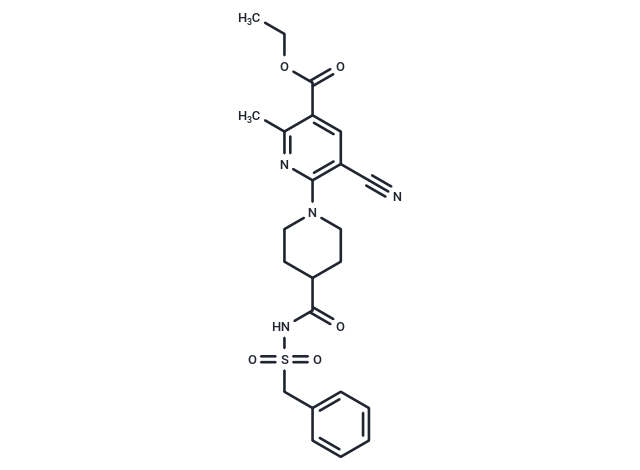Shopping Cart
- Remove All
 Your shopping cart is currently empty
Your shopping cart is currently empty

AZD1283 is an effective P2Y12 receptor antagonist (EC50: 3.0 ug/kg/min, binding IC50: 11 nM). AZD1283 dose-dependently induced increases in blood flow and inhibition of ADP-induced platelet aggregation with antithrombotic ED50 values of 3.0 and 10 μg/kg/min, respectively. The doses induced the increase in bleeding time at 33 and 100 μg/kg/min for 3- and 13-fold, respectively. Thus, the therapeutic index (TI) was ≥10 for both compounds.

| Pack Size | Price | Availability | Quantity |
|---|---|---|---|
| 1 mg | $31 | In Stock | |
| 2 mg | $44 | In Stock | |
| 5 mg | $72 | In Stock | |
| 10 mg | $126 | In Stock | |
| 25 mg | $222 | In Stock | |
| 50 mg | $355 | In Stock | |
| 100 mg | $592 | In Stock | |
| 500 mg | $1,270 | In Stock | |
| 1 mL x 10 mM (in DMSO) | $74 | In Stock |
| Description | AZD1283 is an effective P2Y12 receptor antagonist (EC50: 3.0 ug/kg/min, binding IC50: 11 nM). AZD1283 dose-dependently induced increases in blood flow and inhibition of ADP-induced platelet aggregation with antithrombotic ED50 values of 3.0 and 10 μg/kg/min, respectively. The doses induced the increase in bleeding time at 33 and 100 μg/kg/min for 3- and 13-fold, respectively. Thus, the therapeutic index (TI) was ≥10 for both compounds. |
| Targets&IC50 | P2Y12 receptor:11 nM |
| In vivo | Acute administration of dasotraline dose-dependently decreases the spontaneous firing rate of LC NE, VTA DA and DR 5-HT neurons through the activation of α2, D2 and 5-HT1A autoreceptors, respectively. Dasotraline predominantly inhibits the firing rate of LC NE neurons while producing only a partial decrease in VTA DA and DR 5-HT neuronal discharge. SEP-225289 is equipotent at inhibiting 5-HT and NE transporters since it prolongs to the same extent the time required for a 50% recovery of the firing activity of dorsal hippocampus CA3 pyramidal neurons from the inhibition induced by microiontophoretic application of 5-HT and NE[1]. Average dopamine and serotonin transporter occupancies increase with increasing doses of SEP-225289. Mean dopamine and serotonin transporter occupancies are 33%±11% and 2%±13%, respectively, for 8 mg; 44%±4% and 9%±10%, respectively, for 12 mg; and 49%±7% and 14%±15%, respectively, for 16 mg[2]. |
| Molecular Weight | 470.54 |
| Formula | C23H26N4O5S |
| Cas No. | 919351-41-0 |
| Smiles | CCOC(=O)c1cc(C#N)c(nc1C)N1CCC(CC1)C(=O)NS(=O)(=O)Cc1ccccc1 |
| Relative Density. | 1.36±0.1 g/cm3 (20 °C, 760 mmHg) |
| Storage | Powder: -20°C for 3 years | In solvent: -80°C for 1 year | Shipping with blue ice. | |||||||||||||||||||||||||
| Solubility Information | DMSO: 22.5 mg/mL (47.82 mM), Sonication is recommended. | |||||||||||||||||||||||||
Solution Preparation Table | ||||||||||||||||||||||||||
DMSO
| ||||||||||||||||||||||||||

Copyright © 2015-2025 TargetMol Chemicals Inc. All Rights Reserved.